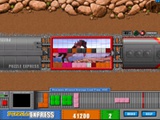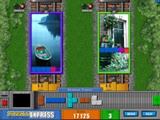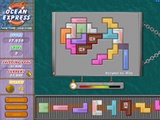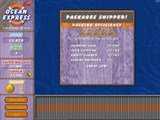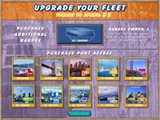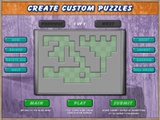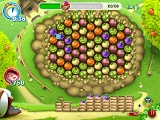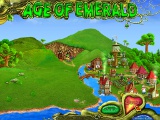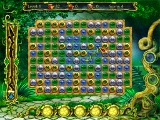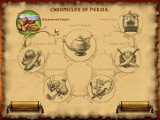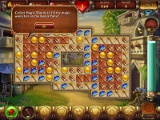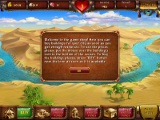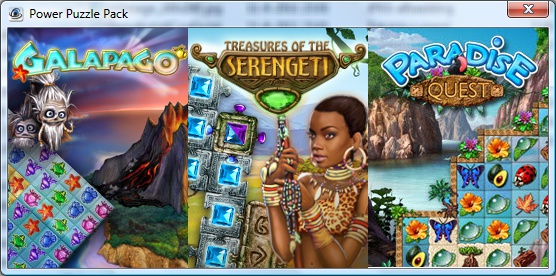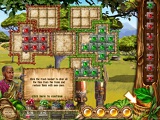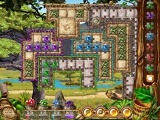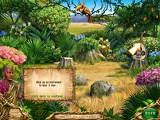





Puzzle Express (demo)
An Acer GameZone demo and vintage game by HipSoft, it plays like Tetris, only
the pieces, instead of dropping down, are supplied on a conveyor belt and can be
dragged onto the playfield, optionally after rotating. In this game, the
playfield is a train wagon, seen from above, generally rectangular with some
squares filled in. When pieces fill a whole line across the playfield, it
disappears, just as in Tetris, but instead of dropping the pieces above it, it
simply uncovers a strip of the image below. That does mean that orphaned 1-block
squares can never be filled by making space above them, but no fear, the game
supplies a limited number of 1-block square pieces from a space to the left of
the conveyor belt to fill those little mistakes. Warning: once you run out of
these fillers, the game is over.
The game starts with cheerful choo-choo-train music that becomes more
unobtrusive while the wagon is being loaded, and sounds a harmonica when
starting in a new city. In the opening screen, I can choose between Scenic
(un-timed) and Express (timed, special pieces) play mode, and under Options, I
can choose if I'm connected to the Internet (default value Yes, since anytime I
lose, the game tries to upload my score somewhere) and if so, whether I should
automatically download new background images for the playfield. There is also an
option to use custom images. I didn't look into this further, as the game is
old, and surely HipSoft won't be keeping an archive of images up for download
forever. Still, each time I restart the game, a screen optimistically asks me if
I want to download new images.
Before the playing starts, I click my way through several screens of tips,
one of them being the key combinations I can use instead of buttons. Now that's
vintage! As is the fact that I need to save first, then quit. Most casual games
autosave upon quitting. What station I start at seems to be random; the first
time it was Juneau, Alaska, then I was given a choice between Richmond and
Topeka. How the trains are packed also varies; usually there is one wagon that
pulls out when full, but there may be two side-by-side. Conveyor belt behaviour
also varies; at first, the pieces collect until the conveyor belt is full and
stops moving until I throw some pieces in the trash (which costs points) to make
space. Later in the game, pieces roll up and straight into the trash if I don't
pick them up fast enough. Additionally, a screen warns me that if I let the
conveyor belt fill up until it stops, the game is over.
Playing in Scenic mode, I'm shown a description of every town the train goes
to, all of which appear to be in the USA. The descriptions are a bit optimistic,
like the one of Topeka which mentions its anti-slavery past, but not its biggest
tourist attraction since then, Fred Phelps (RIP, or, as he would have it, BIH).
Ocean Express (demo)
Another Acer GameZone demo, HipSoft product and successor to Puzzle Express, Ocean Express has a number of improvements. Again,
the idea is to fill a container - this time, not a train but a barge - with
pieces so that no empty space is left, after which it leaves and a new container
comes into view, or the next level starts. The improvements are that the game
automatically saves on quitting; the containers are not rectangles but the
oddest shapes, making the fitting of pieces a more interesting challenge;
one-square holes don't need one of a limited supply of one-square pieces, but
are simply deducted from the score; and instead of just being randomly sent to
one city or another, the player starts with a few "free" city ports and has to
buy access to more ports, as well as more barges, with credits collected in each
game. It could be considered a step back that this game is less like real Tetris
in that filled lines don't disappear, and so won't uncover a background image,
but this also means no more connecting to the Internet for more images or to
upload highscores. Lastly, it's subjective, but I found the musical intro to be
unexpectedly nice, with a touch of harp, although as with the train game the
background music still has travel-related sounds, now ship's horns and gulls.
Again, there is a scenic and timed mode, called Casual and Expert. Both modes
start with a financial goal that must be met or exceeded. This time, not all
locations are in the USA. For each new port accessed, a new, problematically
shaped piece of cargo is added for that port's main export product - in case of
New York, pizza. I start with two barges, the second one towed into view when
the first one is as full as possible; cargo pieces accumulate on the conveyor
belt and make it stop when full, so if I have to make room for new pieces or
accidentally picked up a piece I can't use, I have to drop it in the ocean,
which is, of course, penalized. To add a challenge, a coin may appear in the
cargo hold that I have to drop a piece on to get an extra credit coin, or a
cargo piece with special effects may appear on the conveyor belt. At the end of
the level, I'm shown a screen of how I did, giving my totals and a rating in
anchors. (Note that when I bought more barges, I still had the same amount of
time to fill them, so my anchor rating was halved.)
Where Puzzle Express has custom images, Ocean Express lets players make their
own puzzles (cargo hold shapes). Finished puzzles can be used in one's own game
or submitted online to HipSoft, assuming (given the game's age) HipSoft still
accepts submissions. And so, when I restart the game, I get the question whether
I want to download more puzzles. Having made some, I don't intend to upload
them, as they have the creators' user names on them, and I think other players
would take it the wrong way if they saw a puzzle labeled "Designed by fuckyou".
Green Valley (demo)
This demo was installed not once, but twice: as part of the Acer GameZone
demos, and as a demo from one of the supermarket CDs. The second time I thought:
hey, let's grab a screenshot before scrubbing it. Because this is a frustrating
game, and not one I want to spend any time on, ever.
This is a samegame. Not the kind where you click one in a row of similar
tiles and they all go poof, but one where you have to trace a path over the
similar tiles yourself, so if you missed one or have to leave one out because
you'd have to cross your path to get to it: tough cheese. In this case, the
playfield is a honeycomb of fruits and vegetables. Draw a path over them, and
they fall out (and new tiles drop down). What do they fall into? The empty
crates that a little insectoid game character is constantly putting under the
honeycomb while removing the full ones. What if there aren't enough crates? The
veg smashes to pieces on the ground. OUCH. That is NOT how you treat eggplant.
Or pumpkin. Or anything with food value.
I also hate the 3D character design. Because a 3D look in Oberon Media games
seems to mean that the characters must look naff. These characters are insects -
bees, if I recall correctly - happily selling off the produce of their vegetable
garden. They look too dumb to tie their own shoelaces, or, to stick to the
insect theme, clean their own feelers. Not funny. Just dumb. No wonder they
waste so much food.
This game is listed on the Big Fish
Games site as "Green Valley: Fun on the Farm".
Age of Emerald
Hello, not a demo! But a game on CD bought cheap at the supermarket along
with golden finds like Mystery of Unicorn Castle
(hidden object) and Atlantica (match-3). Out of all
the CDROM sleeves with elves and fairies on the cover, I picked what may have
been the worst. Like Green Valley, this is a samegame where you
have to trace your own path. Fortunately, nothing falls to waste, but there is
the irritation of having missed a tile. Also, tiles don't drop but follow the
path of the tiles I just cleared, so that shapes I'd hoped to tackle in the next
move are ripped apart. Fortunately, there are special powers like "hammer" and
"dynamite" to break up the playfield when it becomes too fragmented.
The backstory is that elves need a village built for them. There is a graphic
of someone (the head elf?) that looks horribly like a cartoon of Benjamin
Franklin. There is a green forest clearing scene that, in the course of the
game, becomes increasingly cluttered. And there is a playfield of tiles, a
different shape for each level, with three types of tiles and a timer that runs
out far too quickly. The tile types are Money, Food, Magic, and come in
gradations. Say, a coin tile is good for 1 Money, and a Diamond for 2 Money.
Apples are 3 Food, but Fish are 4 food. This is supposed to make me think ahead:
do I ruin a clump of fish tiles just to score me some apples, or do I ignore the
apples and go for the highest prize? But it just irritates me, as there is no
time to think. Clearing a path on stone or metal squares doubles the tile value
and destroys the squares, making a funny sound effect that is the only enjoyable
part of the game. After every level: do I have enough Money, Food, and Magic to
buy the next structure? If so, buy structure, play next level. Else, play next
level. Wow!
I used to play this game brainlessly when in need of relaxation, but it is
slightly too hard for brainless play, doesn't relax me, and the background
music, which may be supposed to sound elfin, reminds me of a cold draughty
house. It gives me a headache.
Cradle of Persia from The Cradle
Bundle (demo)
I thought that this was a bundle of two match-3 games. Imagine my horror when
I found that the first game in the bundle was another samegame. It seems easier
than Age of Emerald (because there are less tiles?) and there
are more challenges: tiles that are locked down, or on wood, or blocked by
squares of iron. There is a "wildcard" tile, that, unlike the "plus" tile in Age
of Emerald, will not combine two different tiles, and although I'm still
supposed to destroy all stone tiles, this time it's mandatory, and as soon as
they are all destroyed, THE LEVEL ENDS, so tough luck if I still had time to
collect more points. The timer is a tube of water that empties with a slush when
it runs out, or when all stone squares are gone. I have three lives, so
presumably I lose a life if the timer runs out before the stones are gone.
In a vaguely educational way, the history of Persia under its different
rulers is now a collection of levels, presented as a progression rather than a
change of regime. For each level, I get a new background image. The number of
points gathered allows me to buy buildings to clutter up the scene, but also
advances me as a player. The player screen initially shows a question mark, but
will later display a graphic representing the player's rising status. I made it
to "nomad", a naff, slightly bug-eyed bedouin caricature. The game is, at least,
better to look at and listen to than Age of Emerald; the "modern" BGM playing
when I open the bundle changes to oriental music when I choose Persia, and the
backgrounds are nice enough that I'm annoyed when the game changes them. Like
the Amazing Adventures bundle, this is a real
two-in-one executable: CradleBundle.exe, which makes it easier to reprioritize,
as the game was horribly slow until I found out that constant polling for a
network connection was what slows the computer. Playing it while connected to
the internet, I saw what I had first seen when playing Glyph 2 while online: an advert and a "thank you for
supporting our sponsors", from Oberon itself this time. Apparently all Oberon
games do this. I'm glad that I now play with network disabled.
Treasures of the Serengeti from
Power Puzzle Pack 3-in-1
Included in Power Puzzle Pack 1-in-3 with the match-3 games Galapago and
Paradise Quest, this is definitely not a match-3 game. It is midway between
Tetris and SameGame, and the best representative of the genre "jigsaw", which
also includes Puzzle Express, because it uses actual jigsaw
pieces.
The geography and cultural depiction is as hokey as can be expected of any
Oberon game. Asha is the shaman of a primitive African tribe, despite looking
like a cosmetics-wearing modern black American, with covered breasts and no
facial scarification, nose and lip plugs or any, you know, traditional African
stuff. The only hint that she might be an important person in the village is her
overload of jewellery. She has gone to the desert for a bit of meditation (like
any shaman in Africa, right?) and returned to an empty village. Plot device:
wild elephants have trampled the village, so the villagers, logically deducing
that the village must be cursed, left in droves, and the only way to get them
back is to rebuild the village. And the only way to do that is to gather
gems.
I've never played a tetris variant like this before: first, shapes built out
of rectangles come into view from behind a tree. I'm told these shapes are
baskets. Then, puzzle pieces fall down the inside of the tree. Jigsaw pieces
have to be fit together inside the baskets, which is simple enough. Some
"baskets" have a coloured line and should only have pieces of that colour in it,
but I automatically always linked pieces of the same colour, which got me praise
for making chains of five or more pieces of the same colour, indicating that
this is also a samegame. Once a basket is full, it explodes and all the gems
I've earned drop into one of four urns. I wondered at the lack of a timer, and
found that the baskets are the timer; they slowly scroll leftwards, and when
they pass the screen's left margin, I lose the level. The level is won when all
baskets are filled on time, which becomes harder as little complications are
added, but the game also adds tools like a puzzle piece that fits anywhere and a
hammer to break up problem chains.
Between levels, the village elder tells the player what village feature to
restore using the gathered gems, and there may be a minigame to play. This is
what makes the game real fun, as, for the short time that I played, all
minigames were about music. Of course the game itself plays nonstop Generic
African Tribal Music, but not only are the minigames about things like matching
two items that play the same soundbyte or tuning strings until they sound the
right note, but the goal of these games is to recover the village's missing
instruments one by one. Each recovered instrument is placed in a secret grove,
where you can make it play by clicking on it. Each instrument placed there has
its own tune, and when they're all assembled and playing together, they're quite
the orchestra.
